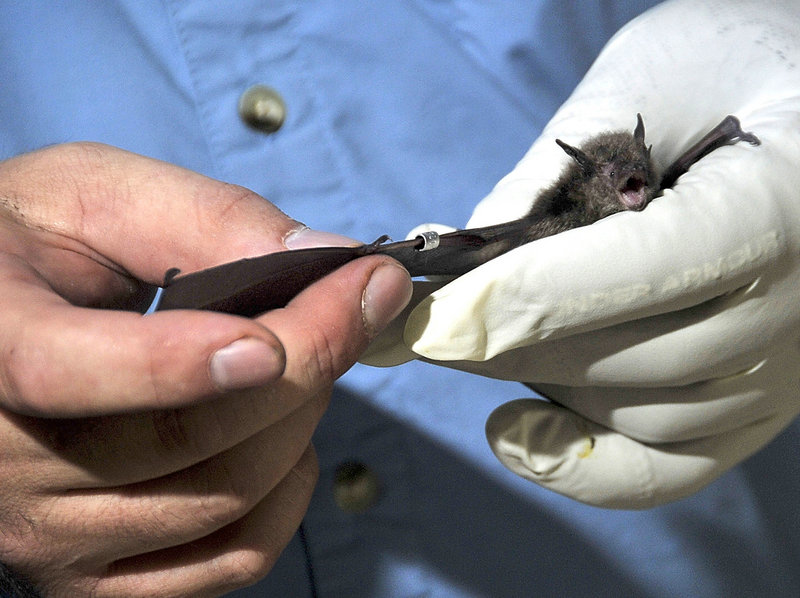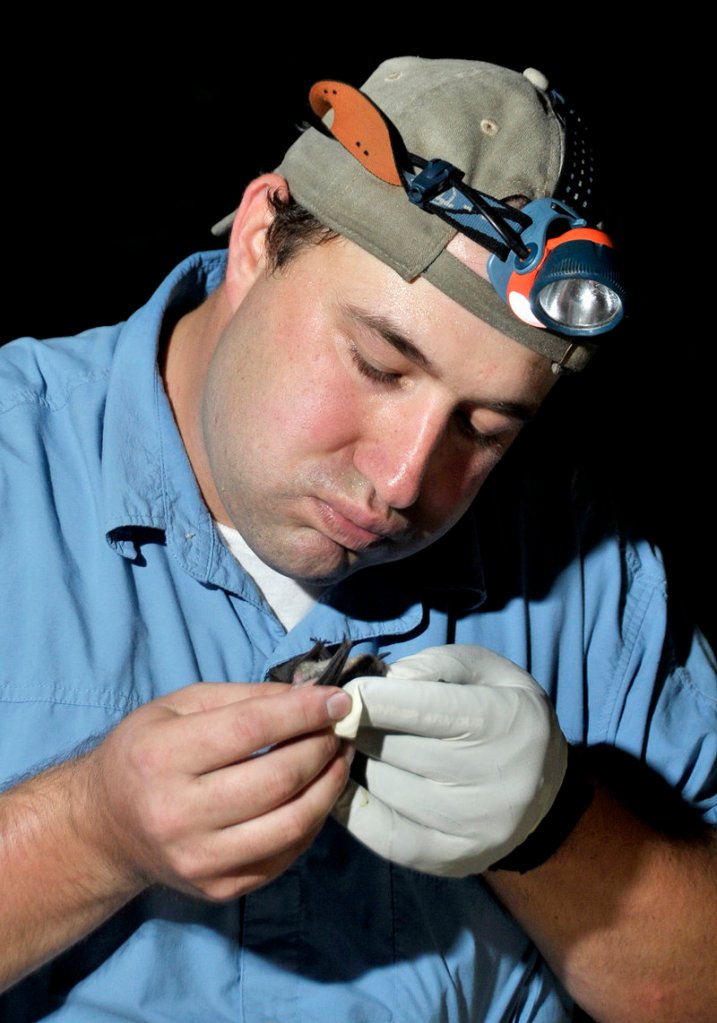CAPE ELIZABETH – At ten past 8 on a recent night, the bats began to emerge from their sleeping quarters.
They would go for a drink at Great Pond before dining on the local insect population. But first, David Yates intended to snag some of them in his nets, to show them to his audience.
“It’s been a good night for bats,” said Yates, a bat biologist.
Yates was talking to 20 adults and children who assembled in the dark for the BioDiversity Research Institute’s annual bat catch. Dressed in warm clothes, carrying flashlights and reeking of bug repellent, the group hovered around Yates at his field table to see the night’s catch: 10 bats, each in a white mesh bag.
Yates and other researchers are in a race to learn more about environmental threats to the understudied mammal. He is one of two bat experts on the staff of the BioDiversity Research Institute in Gorham, which works to determine emerging environmental problems for wildlife and ecosystems.
The institute’s research assistant Tim Divoll is spending his summer at Acadia National Park, studying the population dynamics of bats living in that area.
Yates said bats provide a valuable service, eating the equivalent of their own weight in insects each night. For the little brown bat, that’s 6 grams, about the weight of six paper clips.
Bats are an important defense against insects that spread disease and threaten agriculture, Yates said. They’re also under siege, from diseases, contaminants and environmental changes.
White-nose syndrome, a fungus that spreads among hibernating, cave-dwelling bats, has quickly decimated the little brown bat population, although it has yet to be found in Maine.
First detected in New York in 2006, the fungus causes bats to come out of hibernation too early.
Lacking food sources in the middle of winter, they quickly burn up their tiny fat reserves.
The disease has killed more than a million bats in the Northeast. It has spread west to Oklahoma and south to Tennessee. Some experts predict the disease will wipe out the little brown bat population, which is especially vulnerable to the fungus, within two decades.
Bats are also threatened by toxic substances such as mercury and PCBs from industrial pollution. Much of Yates’ work has focused on mercury levels in bat tissue.
He has studied only a handful of the 1,100 known species of bats. Maine is home to eight species.
Tree bats appear to be especially affected by the blades of wind power turbines, but no one knows why. Yates said it could be that tree bats follow ancient migration routes along the mountain ridges where the turbines are most often erected.
He said another theory is that tree bats, which swarm in the tallest available tree during mating, are confusing the soaring turbines with trees.
Compared with other wildlife, bats are understudied largely because they are night creatures. Unlike birds and diurnal mammals, bats are awake when most researchers and nature lovers are asleep.
“You don’t see them easily,” said Divoll.
That’s why many people are scared of the tiny, furry creatures, said Yates. People haven’t had enough personal experience with bats to appreciate their finer qualities.
“They are not a bad thing. You don’t have to take your tennis racket out and ping pong them out of the house,” said Yates.
The group that took the bat walk was clearly entranced.
“I am not against bats,” said Sydney Fitzgerald, 11, of Portland, whose family was wait-listed for last year’s bat catch.
They huddled around Yates as he plucked each bat from its mesh container.
The group fired off questions and offered up observations. They oohed and aahed as Yates removed each new specimen.
Yates, who had bagged three species for the group, weighed each bat, tagged it and took other measurements before releasing it back into the night sky.
Yates told the group that little brown bats can live as long as 38 years, and that the female gives birth to a single baby each year.
Examining a female little brown bat, he told the group that it hadn’t lactated so it hadn’t reproduced this year.
Someone in the group piped up: “That’s because she is putting her career first.”
Staff Writer Beth Quimby can be contacted at 791-6363 or at: bquimby@pressherald.com
Send questions/comments to the editors.





Success. Please wait for the page to reload. If the page does not reload within 5 seconds, please refresh the page.
Enter your email and password to access comments.
Hi, to comment on stories you must . This profile is in addition to your subscription and website login.
Already have a commenting profile? .
Invalid username/password.
Please check your email to confirm and complete your registration.
Only subscribers are eligible to post comments. Please subscribe or login first for digital access. Here’s why.
Use the form below to reset your password. When you've submitted your account email, we will send an email with a reset code.